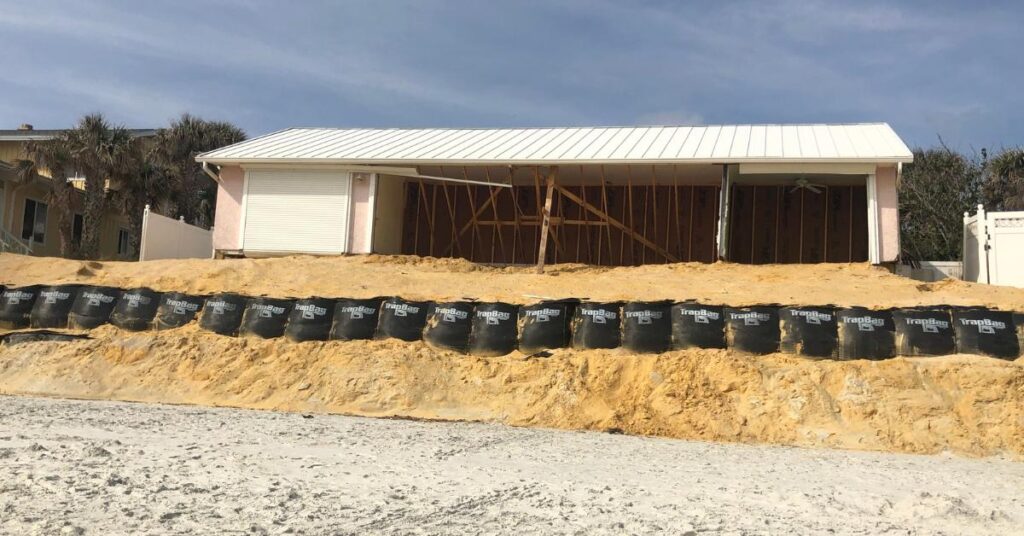How TrapBag Prevented Daytona Beach Erosion from Nicole and Ian
The Daytona Beach erosion that occurred after Florida was struck by two hurricanes has endangered homes and businesses. TrapBag is helping to protect them.

After two hurricanes hit Volusia County’s coastline in late 2022, homes and businesses along the ocean were put at serious risk of damage from erosion. In the months since, thousands of TrapBag seawalls have been deployed to save the structures along the coast.
Volusia County’s Beach Erosion Problem
Florida is still recovering from both Hurricane Ian and Hurricane Nicole, which battered the state last fall. Hurricane Ian was a Category 5 Hurricane that caused an estimated $67 billion in damages, and Category 1 Hurricane Nicole followed weeks later, causing approximately $1 billion in further damages. Both storms led to a combined total of more than 150 deaths.
In addition to the immediate loss of life and property that hurricanes cause, they also lead to significant erosion—both during and after the storm. The immediate erosion is caused by the massive waves and storm surges. The force of the water can push the sand further inland or take it out to sea.
Existing seawalls and flood prevention infrastructure, especially if it’s starting to age, can be overwhelmed by the floodwaters and fail. Once the initial damage is done by a hurricane, the barriers that once protected an area from beach erosion by standard waves can be severely weakened. Those barriers can also take months to deploy. Even six months after the Hurricanes hit Volusia County, many of the beaches remained unprotected.
This can lead to significant erosion in the weeks after a hurricane hits, and property owners have a limited amount of time to put new measures in place. This can be difficult to do because they will be competing with their neighbors for supplies and assistance at a time when communication and regular processes are severely impeded. Hurricane Ian, for instance, left more than two million people without power.
Daytona Beach Hurricane Damage
When hurricanes Ian and Nicole struck Daytona Beach, they took massive chunks out of the shoreline, causing homes and businesses to collapse into the beaches below. Many of the businesses along the coast remained closed for months after the hurricane hit the area. At least 93 buildings were affected in Daytona Beach Shores, with an estimated $363 million in reported damages.
New Smyrna Beach Hurricane Ian Damage
The two hurricanes caused more than $50 million in estimated damages in New Smyrna Beach. In the immediate aftermath of Hurricane Nicole, some residents said their homes were just feet away from the edge of the beach, and they were losing ground quickly.
How TrapBag is Preventing Beach Erosion in Florida
After the hurricanes destroyed many of the existing seawalls in Volusia County, hotels and condo associations turned to TrapBag for help. More than 60,000 linear feet of TrapBags have been installed.
“If there is nothing there to protect it, the sand is just gonna erode away…” a contractor hired to install the system told reporters. But a TrapBag seawall was able to stop that from happening, he said. “The waves can hit it all day, all night, and they are not going anywhere at all.”
Since permits are required (and take time to get) to alter or add many permanent seawalls, TrapBags are able to be a strong and reliable solution that can be deployed within a matter of hours. Once residents signed an easement, the county was able to access the properties and deploy the temporary seawall with the help of the Army Corps of Engineers.
The bags were filled with sand, which will make them easy to remove once the danger has passed. They’re expected to remain in place until March 2025, at which time officials said they would pour the filler sand right onto the beach or around the new seawalls.
Erosion Prevention Success Stories with TrapBag
While that may be the biggest TrapBag project to take place in Volusia County after the hurricanes struck Florida, it’s certainly not the first.
Just a few weeks after Hurricane Ian passed over the state, a family in Daytona Beach created a TrapBag seawall to stop erosion from reaching their home. The existing seawall had been destroyed by the storm and the beach had lost a significant amount of sand.
The family wanted to fix the seawall, but they needed to apply for a permit and work with the Department of Environmental Protection to do so. TrapBags were able to buy the family the time that they needed to protect their homes until they were able to find a permanent solution.
Further down the beach, the owners of a local vacation rental property saw that they were in danger of losing their business due to beach erosion. They worked with family and friends to deploy 648 TrapBags and build a seawall in between high tides.
The family also worked closely with TrapBag owner Buzz Wade to make sure their flood barrier was deployed effectively. “Buzz walked me through the installation,” one of the business owners told local reporters. “I owe him for helping us save our business.”
Why Choose TrapBag?
TrapBag flood barriers are engineered to be affordable and flexible options for a variety of flood and erosion control solutions. Their pentagon-shaped structure makes them far more efficient than sandbags and easier to deploy. They can be filled with sand, washed gravel, and concrete and are used for both temporary and permanent jobs.
TrapBag Solutions
- Erosion control
- Retaining walls
- Diversion barriers
- Tailing and check dams
- Cofferdams
- Berm elevation
- Water reservoirs
- Seawalls
- Storm surges
- Gravity walls
- Mechanically stabilized earth walls
- Flood barriers
- Levees and dikes
- Spill control
- River stabilization
- Dune stabilization
- Stormwater containment
Order TrapBag Today
Fighting beach erosion in Florida? Order TrapBags today to buy yourself time and money by quickly deploying a high-quality, temporary seawall.
Meet the author
Get the Dirt Before the Flood Hits
Stay ahead of flooding, erosion, and disaster response challenges. The Dirt, TrapBag’s monthly newsletter, delivers field-tested tips, real-world case studies, and the latest in barrier technology straight to your inbox.

